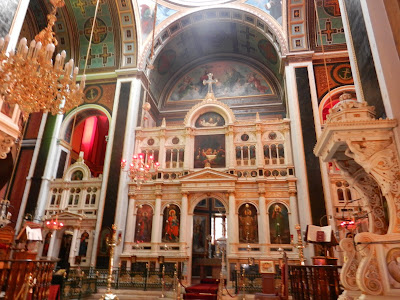We should have gone to Delos – an uninhabited island – with ruins from way back. Designated a UNESCO World Heritage Site, Delos enjoyed a long period of prominence, from 7th century B.C.E. until 88-69 B.C.E. The winds were unfavorable and our captain feared we could not find safe harbor, so we sail to the nearby island of Syros, also in the Cyclades.
Photos from Syros are here.
Photos from Syros are here.
Syros is a lovely town of some tourist attention, but not a destination for large cruise vessels, nor even small ones very often. Our cruise arranges for local guides to walk us through some of the local highlights, though we didn’t get back down to the market to try “Turkish Delight”, which, we are told, was a favorite local sweet. Our fault.
Greece may need austerity, but we see none exhibited. Everything appears to be paved with marble, the churches we visit are gold-encrusted, and the only shops we notice mostly sold "wants," not "needs." The two Greek Orthodox churches we visit are very ornate, and one has a small icon that, after a cleaning a few years ago, was discovered to be by El Greco.
The afternoon lecture is again by Gordon Turnbull "Did Helen Go Willingly? War, Women, Beauty and Violence." During cocktail hour Bard professor Bill Mullen mounts a short reading from Book Three of the Odyssey, describing Nestor's palace at Pylos, including a moving scene between old Nestor and young Telemachus. After dinner we watch Gods and Goddesses, their movie of the evening, on the TV in our cabin.
Greece may need austerity, but we see none exhibited. Everything appears to be paved with marble, the churches we visit are gold-encrusted, and the only shops we notice mostly sold "wants," not "needs." The two Greek Orthodox churches we visit are very ornate, and one has a small icon that, after a cleaning a few years ago, was discovered to be by El Greco.
The afternoon lecture is again by Gordon Turnbull "Did Helen Go Willingly? War, Women, Beauty and Violence." During cocktail hour Bard professor Bill Mullen mounts a short reading from Book Three of the Odyssey, describing Nestor's palace at Pylos, including a moving scene between old Nestor and young Telemachus. After dinner we watch Gods and Goddesses, their movie of the evening, on the TV in our cabin.
John recalls our arrival on a very windy day, huge whitecaps, trying to figure out where we were landing. We in fact landed in a harbor with two enormous dry docks. Not beautiful, but interesting. A massive seawall protected the harbor. We tied up right at the town wharf, a much smoother landing than at the Dardanelles.
We learned we would have a walking tour, with a subsequent release. It was the slowest tour ever. Our guide was heavy and slow, but so were some of our fellow travelers. We climbed to a charming Greek Orthodox church. The little fold-down wooden chairs along the walls were labeled for men, who sat on the right, women were to the left (but our seats were unlabeled). We walked still higher up and visited the architectural museum and saw the icons that were put in graves. There were these flat icons, which struck us as a very early chapter in what we had been looking at. We entered the market to get to the archeological museum and ran into the police/fireman’s protest. This wasn’t Syntagma Square: they weren’t marching, but singing. They had a big banner that we couldn’t read, but there didn’t seem to be any anger in them.
It was our first view of a swimming beach and we were astounded at the clarity and blue-ness of its waters.
We also entered a small, but delightful, renovated theater. The town reminded us a little of Red Wing. The Sheldon Theater in Red Wing is similar: small, but immaculately cared for and, hopefully, prosperous. Municipal theater Apollo: designed as a miniature of LaScalla, in its original form, it has four levels of tiers. Workers were preparing the stage for something upcoming, their sweeping and vacuuming creating a great deal of dust. Its last performance was in 1953.
We learned that the local Greek Orthodox churches always had at least one ostrich egg, the ones we saw were embedded in the chandeliers and not obvious. Our guide talked of saving the red Easter eggs, a symbol of rebirth, and faith, each year. Its archeological museum was just three small rooms in a smallish building, but contained bowls and other artifacts dating to 2700 B.C.E. We were amazed by the medicinal equipment: tweezers, tongs, sewing needles, and other tools.
The scenery was stunning, just as you imagine a small, Greek ocean town.




No comments:
Post a Comment